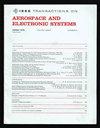基于迭代状态转换的航天器接近层次制导
IF 5.7
2区 计算机科学
Q1 ENGINEERING, AEROSPACE
IEEE Transactions on Aerospace and Electronic Systems
Pub Date : 2024-12-19
DOI:10.1109/TAES.2024.3520081
引用次数: 0
摘要
在本文中,我们提出了一种结合人工势函数和优化方法的受运动和路径约束的航天器接近任务分层制导框架。总体制导方法包括两个主要步骤:1)轨迹点的迭代生成和2)轨迹点对之间的状态转换。在此基础上,利用拟牛顿法迭代逼近目标,生成了包含约束条件的人工势函数。相反,状态转换制导被表述为一个约束最优控制问题,其目标是在结合系统动力学、运动和路径约束的情况下最小化能量消耗。我们证明后者可以利用系统平坦度和b样条参数化转化为凸优化问题,从而减轻了所需的计算负担。该制导控制方法的贡献包括两个方面:1)为传统的人工势函数方法提供了一个实现性能优化的框架;2)与标准模型预测控制方法相比,减少了计算量。大量的数值模拟证实了这一事实,同时也表明了我们的方法在保证安全、快速的航天器接近机动方面的有效性。本文章由计算机程序翻译,如有差异,请以英文原文为准。
Hierarchical Guidance for Spacecraft Proximity via Iterative State Transitions
In this article, we propose a hierarchical guidance framework for spacecraft proximity tasks subject to motion and path constraints by integrating artificial potential functions and optimization methods. The overall guidance methodology consists of two main steps: 1) iterative generation of trajectory points and 2) state transition between every consecutive pair of those points. An artificial potential function incorporating the constraints is proposed in the form of a barrier function, based on which the trajectory points are then generated by iteratively approaching the target through a quasi-Newton method. The state transition guidance, instead, is formulated as a constrained optimal control problem aiming at minimizing the energy consumption while incorporating system dynamics and motion and path constraints. We show that the latter can be turned into a convex optimization problem using the system flatness and the B-spline parameterization, thus alleviating the required computational burden. The contribution of the proposed guidance and control method consists of two aspects: 1) providing a framework to fulfill performance optimization for the conventional artificial potential function methods and 2) reducing the computational burden compared to a standard model-predictive control method. Extensive numerical simulations confirm this fact, along with showing the effectiveness of our method to guarantee safe and fast spacecraft proximity maneuvers.
求助全文
通过发布文献求助,成功后即可免费获取论文全文。
去求助
来源期刊
CiteScore
7.80
自引率
13.60%
发文量
433
审稿时长
8.7 months
期刊介绍:
IEEE Transactions on Aerospace and Electronic Systems focuses on the organization, design, development, integration, and operation of complex systems for space, air, ocean, or ground environment. These systems include, but are not limited to, navigation, avionics, spacecraft, aerospace power, radar, sonar, telemetry, defense, transportation, automated testing, and command and control.

 求助内容:
求助内容: 应助结果提醒方式:
应助结果提醒方式:


